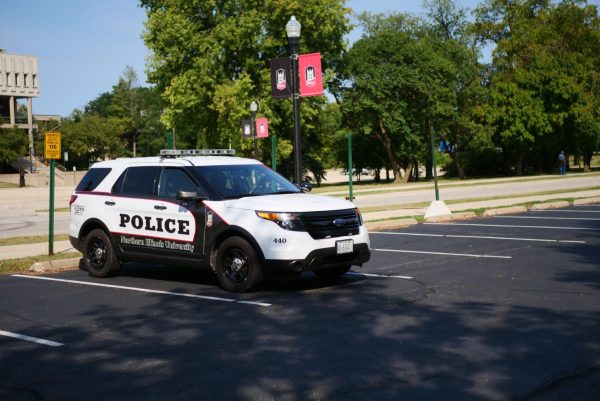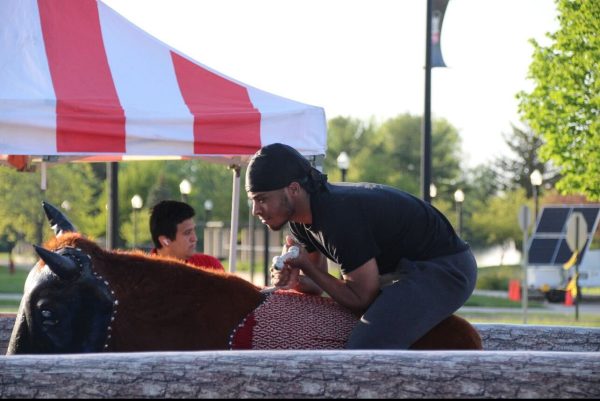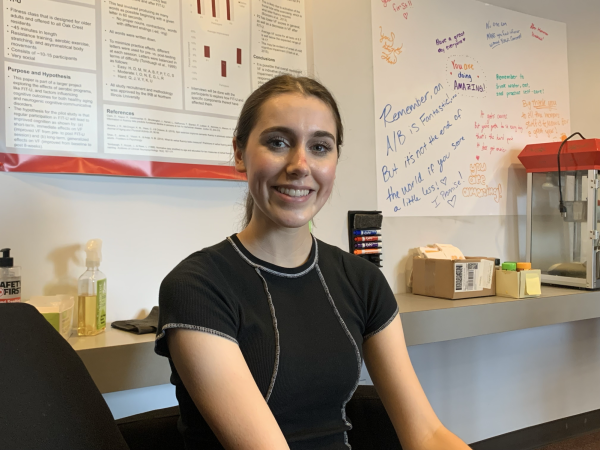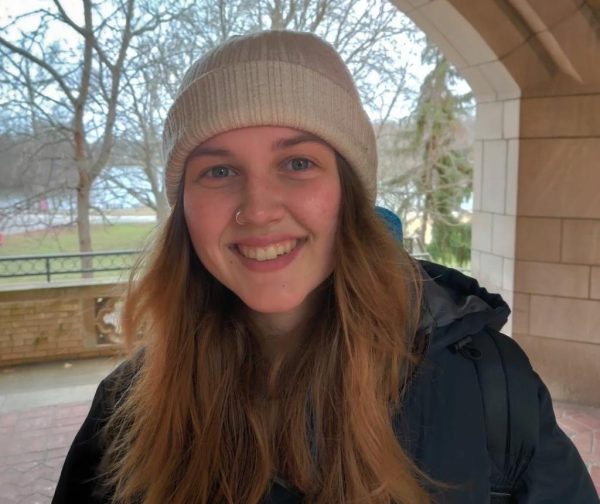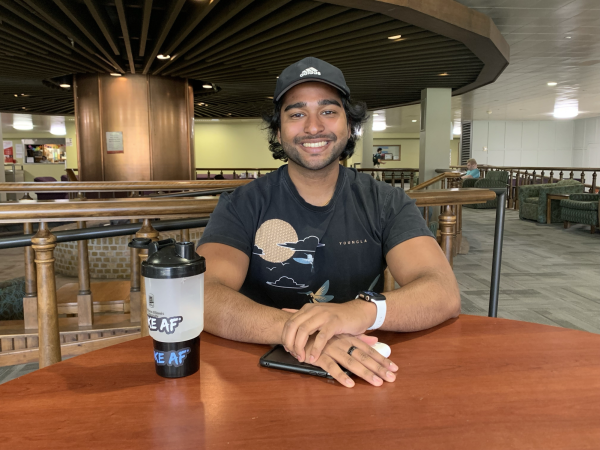Alumni share their stories of social change
February 20, 2020
DeKALB — Five NIU alumni shared their personal stories of social change leadership both on- and off-campus at a university-hosted speaking event titled “125th Anniversary Dialogue on Diversity: Groundbreakers” 7 p.m. Tuesday in the Sandburg Auditorium at the Holmes Student Center.
The speakers were Glenda Blakemore, representing the Center for Black Studies; David Marquez and Liz Monge, representing the Latino Resource Center; Christine Aird, representing the Gender and Sexuality Resource Center and Augustus Mangubat, representing the Asian American Resource Center.
Blakemore recalled the complete lack of support for black students and the extreme racial tensions that existed on campus when she arrived at NIU in 1966.
“The black kids were having difficulties,” she said. “Some were having difficulties to the point of fighting [and] some people were called the N-word. … What were the [resident advisers] doing? They didn’t know; no one had trained them.”
Blakemore shared an anecdote about the time she attempted to join the NIU Sociology Club. At the club, while talking to a professor about issues she and others had been facing on campus, she was met with a racist remark from a white man, she said.
“This [white] guy turned around and looked at me … and said, ‘You need to go back where you came from,’” she said. “And then the professor, his way of managing the situation, was to tell them to treat us like we were a disenfranchised wife, or a wife who had been cheated on.”
To give black students a voice, Blakemore and others started the Black Student Union in 1967. She said the organization would meet to discuss the changes it wanted to see implemented by the university and was actively involved in protests, including marches and sit-ins.
In 1968, the NIU Black Choir was formed because none of the church services in DeKalb felt familiar to black students, Blakemore said. That same year, about 200 black students held a demonstration where they walked into then-President Rhoten Smith’s office and presented him with seven demands.
“We wanted not just to be here; we wanted to thrive here,” she said. “We wanted the university to pay attention to us and want us to graduate. We wanted to graduate because of, not in spite of, the university.”
Blakemore said it was originally planned that, during her graduation ceremony, the black students would be spread out among the other graduates on the football field. The students insisted they all be seated next to each other in order to be noticed, she said.
“We all sat together,” she said. “And when it was time … for our class [to rise], you could see us. Everybody rose, we were all together, but you could see us… And that’s what we wanted.”
Marquez and Monge helped to co-found El Pueblo Unido, a sociopolitical student organization and advocacy group, at NIU in 1992.
Monge said she worked on the organization to discover who she was because nothing on campus at the time reflected the Latino identity.
“I was actually censored by a women’s studies professor, and I got an F in the class,” she said. “So, at that point, I’m feeling pretty dejected.”
El Pueblo Unido came out as an organization through a string of editorials in the Northern Star, Monge said. In 1992, El Pueblo Unido assembled a protest called “500 Years of Resistance” against the 500th anniversary of Columbus’ voyage to the Americas.
“We worked really hard with [other student organizations] to try to change the conversation and to build up to this momentum of protesting 500 years of resistance as 500 years of indigenous culture, manifesting that our history did not begin with colonization or with slavery,” Monge said.
Through networking with other student organizations such as the Organization of Latin American Students, Alpha Psi Lambda, Sigma Lambda Beta and more, El Pueblo Unido was able to gather a crowd of about 8,000 student protesters at the MLK Commons, Monge and Marquez said.
The students fought for a comprehensive Latino Studies program on campus and for the Center for Latino and Latin American Studies to be relegated to its own building. The CLLAS, at the time, was located on the fourth floor of Adams Hall.
“Not only did we protest … against the university, but we also protested against our own,” Marquez said. “We had a director of the Center for Latino Studies who wasn’t quite on board yet, and we protested against him, too.”
In 1993, there were plans by the university to construct a multipurpose sports arena for $30 million. Because of this project, the university had proposed to raise the student activity fee by $50 per semester, much to the anger of the students, Marquez said.
“[The university] kept pushing it and pushing it,” he said. “So, we organized. We’re like, ‘Not gonna happen.’”
Then-NIU President John La Tourette offered to put aside a couple hundred-thousand dollars for a new Center for Latino Studies on the condition that the university move forward with the sports facility project. The students denied this request, Marquez said.
“We’re not tying a multipurpose arena to the building that we so rightfully deserve,” he said. “We knew that, if we did that, we would always be known as, ‘Oh yeah, Latino students, yeah, you guys are the ones who sold us out.’”
Monge said the social change leaders at NIU who came before them served as an inspiration in the group’s fight for an improved Latino Studies program and facility.
“We had a platform, and the platform was: we want Latino Studies,” she said. “We’re aligning with other groups of color across campus, and we want the building. You can’t take away what we have fought for, and so we were always connecting back to the history of NIU.”
Aird said she grew up being insecure about her attraction to other girls. So, to cope with this attraction, she created an imagined male alter ego for herself named Travis, she said.
“I never shared that with anyone until much later in life,” she said. “But at the time, Travis guided my fantasy world most days. It was Travis who could be attracted to other girls and live out my desires, at least in my head.”
In 1981, Aird became more comfortable with expressing her sexuality after attending an NIU women’s rugby party.
“That was the night that opened my world,” she said. “I began to make new friends that identified mostly as gay and lesbian, and I learned about … the Gay-Lesbian Union at NIU.”
Soon after, Aird began to volunteer with the GLU, which she said set the course for her LGBTQ+ advocacy later in life.
Aird said while working as assistant superintendent for elementary programs in the East Aurora School District 2011, she received a phone call from an assistant principal who said a first-grade girl identified as a boy and wanted to use the boy’s bathroom
“In January 2012, I reached out to Nancy Mullen, the director of Youth Outlook, for support,” Aird said. “We arranged a meeting at the school with those who would be involved in supporting that student.”
Youth Outlook, an Illinois-based nonprofit committed to supporting LGBTQ+ youth, went on to test its Being Me program, designed to build self-esteem in elementary-aged students at the school, Aird said.
“[The program] was a great success,” she said. “During the same time, I reached out to David Fischer, with the Illinois Safe Schools Alliance, to begin investigating and researching policies and procedures to support transgender and gender non-conforming students.”
Aird said she and Fischer gathered information to present to their cabinet and district attorneys throughout May 2012. This resulted in a three-page policy proposal, which Aird said was meant to foster a safe learning environment for transgender and gender non-conforming students and provide equal access to all school programs, procedures and activities.
“The evening of July 10, [2012], I presented the policy at a board policy and personnel subcommittee meeting,” she said. “I was prepared for questions but there were none. Two board members showed overwhelming compassion through their responses and comments.”
The full board approved the policy on Oct. 15, 2012. This decision was met with intensely negative reactions from anti-LGBTQ+ groups and, five days later, the board rescinded the policy. Aird said, despite the lack of victory, the experience was a meaningful one.
“I would do it again in a heartbeat,” she said. “It was well worth the effort because those headlines, although controversial, drew national attention to the need for exploring policy and procedures for transgender and gender non-conforming students.”
Mangubat said he came to NIU in fall 1999 not knowing anyone on campus, and he felt alienated by the lack of Asian students. In spring 2000, he discovered NIU’s Asian American Association, or AAA, and became a public relations officer.
“I found my family,” he said. “All of a sudden, I was like, ‘OK, I can stay here [at NIU].’”
Mangubat eventually became president of the AAA, carrying the torch for former president Sopheap Long. As president, Long had talked about fighting for a center on campus and staging a hunger strike, Mangubat said.
The AAA hosted many cultural events, including a fashion variety show and United Colors of NIU, which was co-presented by the African Student Association, Mangubat said.
“We were kind of branching out and trying to reach out and get to know the other student organizations,” he said. “And I believe … United Colors of NIU is still going on.”
In 2001, as vice provost for the Presidential Task Force on Asian Americans, Mangubat put together a month-long event in April for Asian American Heritage Month with the goal of uniting all of the Asian American groups on campus.
“Everyone was not always seeing eye to eye,” he said. “Being the president of Asian American Association, it’s like, let’s gather them all.”
The Asian American Resource Center was founded in 2004. Mangubat said he was moved when he visited the AARC in November, expressing joy in Asian American students having something of their own.
“Even though it’s 20 years later, I mean to see everything is definitely like knowing the fruits of your labor,” he said.



